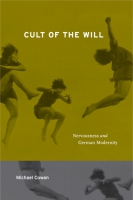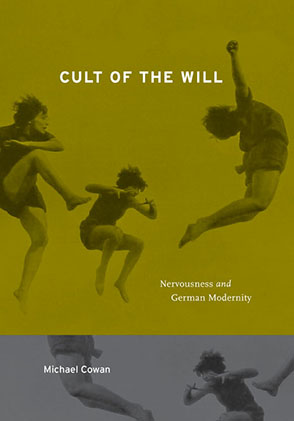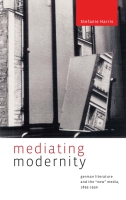Cult of the Will
Nervousness and German Modernity
Michael Cowan
“Cowan’s work presents a pathbreaking and truly meaningful discovery not only in the field of German studies. It belongs to the multiple merits of this book that it participates in the opening and development of a new discursive space within the Humanities. Over the past two decades, much of the historical research on the time between 1850 and 1950 concentrated on the ‘discovery’ of the human body—a historical discovery that took place above all against the hitherto unchallenged dominance of the Cartesian paradigm, and the control and repression of the Christian religious authorities. What Cowan presents is a tendency, during the same historical period, to ‘master’ the body and its fickleness (the ‘nervousness’ in Cowan’s subtitle, a tendency that had a strong impact not only on certain contexts and environments in Western intellectual life but also undoubtedly in the formation of Fascist ideologies and practices. This book should become obligatory reading for all Germanists, not only Germanists working in the period of the late nineteenth and early twentieth centuries. The breadth of the epistemological and cultural dimension is well balanced by the astonishing variety of languages, literatures, and national cultural traditions that Cowan has managed to integrate into this amazing book.”
- Description
- Reviews
- Bio
- Table of Contents
- Sample Chapters
- Subjects
“Cowan’s work presents a pathbreaking and truly meaningful discovery not only in the field of German studies. It belongs to the multiple merits of this book that it participates in the opening and development of a new discursive space within the Humanities. Over the past two decades, much of the historical research on the time between 1850 and 1950 concentrated on the ‘discovery’ of the human body—a historical discovery that took place above all against the hitherto unchallenged dominance of the Cartesian paradigm, and the control and repression of the Christian religious authorities. What Cowan presents is a tendency, during the same historical period, to ‘master’ the body and its fickleness (the ‘nervousness’ in Cowan’s subtitle, a tendency that had a strong impact not only on certain contexts and environments in Western intellectual life but also undoubtedly in the formation of Fascist ideologies and practices. This book should become obligatory reading for all Germanists, not only Germanists working in the period of the late nineteenth and early twentieth centuries. The breadth of the epistemological and cultural dimension is well balanced by the astonishing variety of languages, literatures, and national cultural traditions that Cowan has managed to integrate into this amazing book.”
“Cult of the Will is a superb study that covers familiar terrain with an entirely new approach. Cowan provides very fine examples of interdisciplinary interpretation. His book goes far beyond providing a history of ‘nervousness.’ It finds the implications of psychiatric theory in the internal structure of film, architecture, dance, and literature.”
“Cowan deftly incorporates many contemporary fin-de-siècle examples to argue his central contention that attempts at control were widespread and deemed crucial for a rapidly transforming German society.”
“This story has been often told, but Cowan has found a fascinating and altogether novel way of retelling it, through the lens of the turn-of-the-century preoccupation with overcoming the condition of will impairment, or abulia.”
Michael Cowan is Assistant Professor of German Studies at McGill University. With Kai Marcel Sicks, he is co-editor of Leibhaftige Moderne: Körper in Kunst und Massenmedien, 1918–1933 (2005).
Contents
List of Illustrations
Acknowledgments
Introduction: Reimagining the Will in the Age of Nervousness
1. Capitalism and Abulia
Entr'acte: Willpower in the Age of Enterprise
2. Healing the Will: Popular Medicine and the Emergence of Will Therapy
3. Training the Will: Gymnastics and Body Culture
4. Educating the Will: Reform Pedagogy and the School of Rhythm
5. Mapping the Will: European Nervousness and American Willpower.
Afterword: Notes on the Persistence of Will Therapy
Bibliography
Notes
Index
Pick up almost any of the hundreds of motivational books, cassettes, CDs, and videos on the market today and it will tell you that you possess all the keys to take charge of your own destiny. The obstacles to success and personal fulfillment lie not in factors of class, gender, or ethnicity, not in a lack of material wealth or inherited cultural capital, and certainly not in any structural characteristics of late capitalist society itself—but rather in fear. Accordingly, the secret of those able to direct their lives resides in their ability to overcome inhibition and fear through self-confidence and their belief in their own power and agency. One can certainly debate the merits of such a model; the German sociologist Ulrich Beck has aptly summarized the motivational approach as a search for “biographical solutions to systemic contradictions.” The following study sets out, however, from a different, more fundamental question. When and why did modern human beings develop such an enormous industry whose sole purpose was to convince us of our agency over our destinies? When and how did we come to need so much help learning to live?
Chapter 1 investigates the problem of nervousness and insecurity through a reading of two of the most comprehensive studies on nervousness from the turn of the century. Although German doctors had been writing about the dangers of nervous illness at least since the publication of George Beard’s American Nervousness in 1881, the first systematic attempts to comprehend the problem in a cultural-historical sense came in 1902 with the publication of Lamprecht’s Zur jüngsten deutschen Vergangenheit and Hellpach’s Nervosität und Kultur. Both Lamprecht and Hellpach offered a decidedly economic reading of modern nervousness, attributing its emergence to the instability created by the speculative culture of the Founding Years around 1870—and pointing in particular to the sense of precariousness and fatalism before the whims of an unpredictable stock market. Both writers, moreover, sought to demonstrate the connection between this new sense of insecurity created by modern economics and the rise of a “nervous art”—namely impressionism—toward the end of the nineteenth century. In the second half of this chapter, I demonstrate how this connection between economics, nervous abulia, and impressionist aesthetics informs one of the central novels of fin de siècle abulia: Thomas Mann’s Buddenbrooks (1901). Published a year before Lamprecht’s and Hellpach’s studies, Mann’s novel stages a similar argument about modern abulia not only in its content (the downward narrative movement from the grandfather’s entrepreneurial optimism to the descendants’ pessimistic abulia and radical bodily passivity) but also in its form, specifically its transition from chronicle-style narration to the static interior monologue characteristic of impressionist literature (or what Lamprecht and his contemporaries labeled Stimmungskunst). Reading Buddenbrooks against Lamprecht’s and Hellpach’s analyses also suggests a revision of the view that Mann subscribed to a strict opposition between the “artist” and the “bourgeois.” Nervous art, in Buddenbrooks, along with the abulic psychology it sought to objectify, constitutes less a resistance to capitalism than its logical outcome: not an antibourgeois stance but rather the very aesthetic embodiment of the nervousness of the bourgeoisie.
In subsequent chapters, I turn to three of the key sites—psychology, body culture, and education reform—for the early-twentieth-century mobilization against nervous abulia and the construction of a new bourgeois imaginary based on the values of autonomy and fitness for the insecure new world. In opposition to the oft-repeated contention that early-twentieth-century reform programs constituted a “rediscovery” of the body after its “suppression” under nineteenth-century rationalism, I argue that these programs were driven by precisely the opposite imaginary project: that of taming a rebellious, nervous body in excess. This is not to say that the proponents of will therapy all sought to suppress the body in their turn. Rather, the construction of the imaginary culture of the will entailed a paradoxical project of using bodily performance to solidify the rein of spirit—what the expressionist poet and dance critic Ernst Blass would aptly describe as an effort to “surpass the body with the body [mit dem Leib den Leib überschreiten].”
Also of Interest
Mailing List
Subscribe to our mailing list and be notified about new titles, journals and catalogs.






